Overview
Since assuming the throne from his late father on February 7, 1999, Jordan's 55-year-old monarch King Abdullah II bin Al Hussein (hereinafter King Abdullah II) has maintained Jordan's stability and strong ties to the United States despite ongoing conflicts in two neighboring countries (Syria and Iraq) and recent tensions with its neighbor Israel, with which Jordan has been at peace since 1994. Although many commentators frequently caution that Jordan's stability is fragile, the monarchy has remained resilient owing to a number of factors. These include a relatively strong sense of social cohesion, strong support for the government from both Western powers and the Gulf Arab monarchies, and an internal security apparatus that is highly capable and, according to human rights groups, uses vague and broad criminal provisions in the legal system to dissuade dissent.1
U.S. officials frequently express their support for Jordan. President Trump has acknowledged Jordan's role as a key U.S. partner in countering the Islamic State, as U.S. policymakers advocate for continued robust U.S. assistance to the kingdom. Annual aid to Jordan has nearly quadrupled in historical terms over the last 15 years. Jordan also hosts thousands of U.S. troops. According to President Trump's December 2017 War Powers Resolution Report to Congress, "At the request of the Government of Jordan, approximately 2,300 United States military personnel are deployed to Jordan to support Defeat-ISIS operations, to enhance Jordan's security, and to promote regional stability."2
Jerusalem and Middle East Peace
The Jordanian government has long described efforts to secure a lasting end to the Israeli-Palestinian conflict as one of its highest priorities. The persistence of Israeli-Palestinian conflict continues to be a major challenge for Jordan. The issue of Palestinian rights resonates with much of the population; more than half of all Jordanian citizens originate from either the West Bank or the area now comprising the state of Israel.
The status of Jerusalem is a particularly sensitive issue for the monarchy. Per arrangements with Israel dating back to 1967, and then confirmed in their 1994 bilateral peace treaty, Israel acknowledges a continuing role for Jordan vis-à-vis Jerusalem's historic Muslim shrines.3 A Jordanian waqf (or Islamic custodial trust) has long administered the Temple Mount (known by Muslims as the Haram al Sharif or Noble Sanctuary) and its holy sites, and this role is key to bolstering the religious legitimacy of the Jordanian royal family's rule. Successive Jordanian monarchs trace their lineage to the Prophet Muhammad. Disputes over Jerusalem that appear to undermine King Abdullah II's role as guardian of the Islamic holy sites are perceived by the Jordanian government as a domestic political problem for the King.
In December 2017, President Trump recognized Jerusalem as Israel's capital and announced his intention to relocate the U.S. embassy there from Tel Aviv. Throughout 2017, King Abdullah II had been warning the Administration against such a move, arguing that it would fuel extremism at a time when the kingdom is participating in a global coalition to counter the Islamic State.4 In late January 2018, Vice President Pence visited Israel, Egypt, and Jordan. During the Vice President's meeting with King Abdullah II, the King made public remarks, saying "I had continuously voiced over the past year, in my meetings with Washington, my concerns regarding the U.S. decision on Jerusalem that does not come as a result of a comprehensive settlement to the Palestinian-Israeli conflict.... Today we have a major challenge to overcome, especially with some of the rising frustrations."5 The Vice President responded by saying, "Look, friends occasionally have disagreements, and we agreed to disagree on the decision by the United States to recognize Jerusalem as the capital of Israel.... But what we agreed on was the need for all parties to come back to the table."6
Jordanian officials have argued that the U.S. decision on Jerusalem contravenes United Nations resolutions and violates international law. On January 29, 2018, King Abdullah II hosted Palestinian Authority President Mahmoud Abbas to affirm "Jordan's continued efforts in all international forums to defend the Palestinian cause." In various statements since President Trump's Jerusalem decision, the palace has repeated variations of the following.
- The status of Jerusalem must be settled within the framework of a comprehensive solution that leads to the establishment of an independent Palestinian state, with East Jerusalem as its capital, living side by side with Israel.7
- The U.S. recognition of Jerusalem as Israel's capital is "legally invalid as it enshrines the Israeli occupation of the eastern part of the city, which was occupied by Israel in June 1967." The Jordanian government also argues that U.N. Security Council Resolution 478 does not recognize Israel's Basic Law on Jerusalem (Jerusalem, complete and united, is the capital of Israel) and has called on countries that have established embassies in Jerusalem to close them.8
|
Israeli Embassy in Amman set to reopen Since the summer of 2017, diplomatic tensions between the governments of Jordan and Israel have been high, due to disputes over holy sites in Jerusalem, and to an incident at the Israeli Embassy in Amman in which two Jordanian citizens were killed by an Israeli Embassy employee who claimed to be acting in self-defense. For months, King Abdullah II had declared that no Israeli diplomat would be allowed to return until Israel had launched a full criminal police investigation into the Embassy shooting. Just days before Vice President Pence's January 2018 trip to the region, Israel and Jordan agreed on a compromise solution, which Israel expressed appreciation to the Trump Administration for brokering. According to one source, Israel "expressed regret" to Jordan over the shooting and agreed to pay reparations to the Jordanian government. Israel's Ambassador to Jordan will not return to Amman, but the Embassy will be reopened and a new ambassador will be appointed in the future.9 |
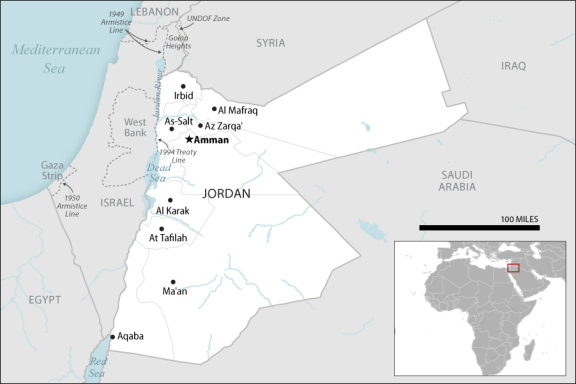 |
|
Area: 89,213 sq. km. (34,445 sq. mi., slightly smaller than Indiana) Population: 8,185,384 (2016); Amman (capital): 1.155 million (2015) Ethnic Groups: Arabs 98%; Circassians 1%; Armenians 1% Religion: Sunni Muslim 97.2%; Christian 2% Percent of Population Under Age 25: 55% (2016) Literacy: 95.4% (2015) Youth Unemployment: 29.3% (2012) |
Source: Graphic created by CRS; facts from CIA World Factbook.
The War in Syria and Its Impact on Jordan
As Jordan confronts the complexity of the war in neighboring Syria, the kingdom finds itself dealing with a host of state and non-state actors, including the Syrian regime of President Bashar al Asad, Russia, the United States, Israel, Iran, Hezbollah, affiliates of Al Qaeda and the Islamic State, and various Syrian rebel groups. In order to stem the flow of refugees, prevent terrorist infiltration, protect select U.S. and Jordanian-supported Syrian armed opposition groups, and prevent non-state actors such as Hezbollah from gaining ground near Jordan's borders, Jordan (like Israel) has sought U.S. and Russian cooperation in limiting conflict in southern Syria.
On July 9, 2017, the United States and Russia announced that both countries would cooperate in overseeing an open-ended cease-fire in parts of southwestern Syria and the creation of a de-escalation zone along the Jordanian-Syrian border. On November 8 in Amman, Jordan, the United States, Russia, and Jordan signed a Memorandum of Principles (MOP), which, according to the State Department, "builds on and expands the July 7th ceasefire arrangement finalized during the last meeting between President Trump and President Putin in Hamburg, Germany, in July."10 The agreement reportedly "reflects the trilateral commitment that existing governance and administrative arrangements in opposition-held areas in the southwest [Syria] will be maintained during this transitional phase. In other words, the opposition is not surrendering territory to the regime, deferring those questions of longer-term political arrangements to the political process under UN Security Council Resolution 2254."11
The signing of the MOP has raised questions over the continued presence of Iranian-backed militias near the Israeli and Jordanian borders. According to the State Department, the MOP would enshrine "the commitment of the U.S., Russia, and Jordan to eliminate the presence of non-Syrian foreign forces. That includes Iranian forces and Iranian-backed militias like Lebanese Hezbollah as well as foreign jihadis working with Jabhat al Nusrah and other extremist groups from the southwest area."12 According to various news accounts, Russia has said that the MOP does not commit it to ensuring that all Iran-linked militias are removed from Syria. Unnamed Israeli sources claim that the MOP would permit militias associated with Iran to maintain positions as close as three to four miles from the Israeli border in some areas.13
During a recent hearing on Syria before the Senate Foreign Relations Committee, Acting Assistant Secretary of State for Near Eastern Affairs David Satterfield responded to a question on the efficacy of the de-escalation zone in southern Syria saying:
The goal of bringing down the level of violence, which was extraordinary and threatening both Jordan and Israel at the time the initial zone was established, before the Memorandum of Principles was signed, was largely achieved. I will note, with the recent exception of a small pocket to the northeast of that zone called Beit Jan, where there was extraordinary levels of violence and presence of Al Qaeda associated forces, by and large, fighting and violence in the de-escalation zone came to a close.14
Since 2011, the influx of Syrian refugees has placed tremendous strain on Jordan's government and local economies, especially in the northern governorates of Mafraq, Irbid, Ar Ramtha, and Zarqa. As of January 2018, the U.N. High Commission on Refugees had registered 655,624 Syrian refugees in Jordan. Jordanian officials claim that there may be hundreds of thousands of unregistered refugees in the kingdom. Jordan has three official refugee camps, Zaatari, Azraq, and Mrajeed al Fhood, which have opened since 2012. While more than 100,000 refugees remain in the camp, the majority of Syrian refugees live amongst the wider population. Due to Jordan's small population size, it has one of the highest per capita refugee rates in the world.
The government, which had already been limiting its intake of Syrian refugees, officially closed all entry points to the kingdom from Syria in June 2016 after a suicide bomb attack on the Jordanian-Syrian border killed seven people at the crossing point near the remote camp at Al Rukban, in eastern Syria. Approximately 50,000 Syrians remain stranded in remote areas of eastern Syria where earthen mounds (or berms) mark the approach to the border inside Syria.15 According to USAID, the population at the unofficial camp near the berm at Al Rukban includes large numbers of extremely vulnerable people—more than half are children. In January 2018, the United Nations expressed appreciation to Jordan for allowing UN agencies to provide an exceptional delivery of humanitarian aid.
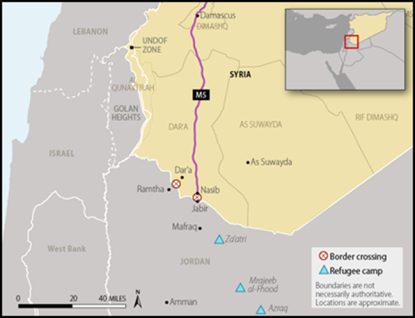 |
|
Source: CRS Graphics. Note: M5 (purple line) is the main north-south highway in Syria. |
Water Scarcity and Israeli-Jordanian-Palestinian Water Deal
Jordan is among the most water-poor nations in the world and ranks amongst the top ten countries with the lowest rate of renewable freshwater per capita.16 According to the Jordan Water Project at Stanford University, Jordan's increase in water scarcity over the last 60 years is attributable to an approximate 5.5-fold population increase since 1962, a decrease in the flow of the Yarmouk River due to the building of dams upstream in Syria, gradual declines in rainfall by an average of 0.4 mm/year since 1995, and depleting groundwater resources due to overuse.17
In order to secure new sources of freshwater, Jordan has pursued water cooperative projects with its neighbors. On December 9, 2013, Israel, Jordan, and the Palestinian Authority signed a regional water agreement (officially known as the Memorandum of Understanding on the Red-Dead Sea Conveyance Project, see Figure 3) to pave the way for the Red-Dead Canal, a multi-billion dollar project to address declining water levels in the Dead Sea. The agreement was essentially a commitment to a water swap, whereby half of the water pumped from the Red Sea is to be desalinated in a plant to be constructed in Aqaba, Jordan. Some of this water is to then be used in southern Jordan. The rest is to be sold to Israel for use in the Negev Desert. In return, Israel is to sell fresh water from the Sea of Galilee to northern Jordan and sell the Palestinian Authority discounted fresh water produced by existing Israeli desalination plants on the Mediterranean. The other half of the water pumped from the Red Sea (or possibly the leftover brine from desalination) is to be channeled to the Dead Sea. The exact allocations of swapped water were not part of the 2013 MOU and were left to future negotiations.
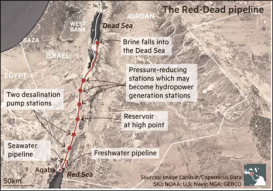 |
|
Source: Financial Times, March 22, 2017. |
In 2017, with Trump Administration officials seemingly committed to reviving the moribund Israeli-Palestinian peace process, U.S. officials focused on finalizing the terms of the 2013 MOU. In July 2017, the White House announced that U.S. Special Representative for International Negotiations Jason Greenblatt had "successfully supported the Israeli and Palestinian efforts to bridge the gaps and reach an agreement," with the Israeli government agreeing to sell the Palestinian Authority (PA) 32 million cubic meters (MCM) of fresh water.18
Congress has supported the Red-Dead Sea Conveyance Project. P.L. 114-113, the FY2016 Omnibus Appropriations Act, specifies that $100 million in Economic Support Funds be set aside for water sector support for Jordan, to support the Red Sea-Dead Sea water project. In September 2016, USAID notified Congress that it intended to spend the $100 million in FY2016 ESF-OCO on Phase One of the project.19
Country Background
Although the United States and Jordan have never been linked by a formal treaty, they have cooperated on a number of regional and international issues for decades. Jordan's small size and lack of major economic resources have made it dependent on aid from Western and various Arab sources. U.S. support, in particular, has helped Jordan deal with serious vulnerabilities, both internal and external. Jordan's geographic position, wedged between Israel, Syria, Iraq, and Saudi Arabia, has made it vulnerable to the strategic designs of its powerful neighbors, but has also given Jordan an important role as a buffer between these countries in their largely adversarial relations with one another.
Jordan, created by colonial powers after World War I, initially consisted of desert or semi-desert territory east of the Jordan River, inhabited largely by people of Bedouin tribal background. The establishment of the state of Israel in 1948 brought large numbers of Palestinian refugees to Jordan, which subsequently unilaterally annexed a Palestinian enclave west of the Jordan River known as the West Bank.20 The original "East Bank" Jordanians, though probably no longer a majority in Jordan, remain predominant in the country's political and military establishments and form the bedrock of support for the Jordanian monarchy. Jordanians of Palestinian origin comprise an estimated 55% to 70% of the population and generally tend to gravitate toward the private sector due to their general exclusion from certain public-sector and military positions.21
The Hashemite Royal Family
Jordan is a hereditary constitutional monarchy under the prestigious Hashemite family, which claims descent from the Prophet Muhammad. King Abdullah II (age 56) has ruled the country since 1999, when he succeeded to the throne upon the death of his father, the late King Hussein, after a 47-year reign. Educated largely in Britain and the United States, King Abdullah II had earlier pursued a military career, ultimately serving as commander of Jordan's Special Operations Forces with the rank of major general. The king's son, Prince Hussein bin Abdullah (born in 1994), is the designated crown prince.22
The king appoints a prime minister to head the government and the Council of Ministers (cabinet). On average, Jordanian governments last no more than 15 months before they are dissolved by royal decree. This seems to be done in order to bolster the king's reform credentials and to distribute patronage among a wide range of elites. The king also appoints all judges and is commander of the armed forces.
Political System and Key Institutions
The Jordanian constitution, most recently amended in 2016, empowers the king with broad executive powers. The king appoints the prime minister and may dismiss him or accept his resignation. He also has the sole power to appoint the crown prince, senior military leaders, justices of the constitutional court, and all 75 members of the senate. The king appoints cabinet ministers. The constitution enables the king to dissolve both houses of parliament and postpone lower house elections for two years.23 The king can circumvent parliament through a constitutional mechanism that allows provisional legislation to be issued by the cabinet when parliament is not sitting or has been dissolved.24 The king also must approve laws before they can take effect, although a two-thirds majority of both houses of parliament can modify legislation. The king also can issue royal decrees, which are not subject to parliamentary scrutiny. The king commands the armed forces, declares war, and ratifies treaties. Finally, Article 195 of the Jordanian Penal Code prohibits insulting the dignity of the king (lèse-majesté), with criminal penalties of one to three years in prison.
Jordan's constitution provides for an independent judiciary. According to Article 97, "Judges are independent, and in the exercise of their judicial functions they are subject to no authority other than that of the law." Jordan has three main types of courts: civil courts, special courts (some of which are military/state security courts), and religious courts. In Jordan, state security courts administered by military (and civilian) judges handle criminal cases involving espionage, bribery of public officials, trafficking in narcotics or weapons, black marketeering, and "security offenses." Overall, the king may appoint and dismiss judges by decree, though in practice a palace-appointed Higher Judicial Council manages court appointments, promotions, transfers, and retirements.
Although King Abdullah II has envisioned Jordan's gradual transition from a constitutional monarchy into a full-fledged parliamentary democracy,25 in reality, successive Jordanian parliaments have mostly complied with the policies laid out by the Royal Court. The legislative branch's independence has been curtailed not only by a legal system that rests authority largely in the hands of the monarch, but also by carefully crafted electoral laws designed to produce pro-palace majorities with each new election.26 Due to frequent gerrymandering in which electoral districts are drawn to favor more rural pro-government constituencies over densely populated urban areas, parliamentary elections have produced large pro-government majorities dominated by representatives of prominent tribal families. In addition, voter turnout tends to be much higher in pro-government areas since many East Bank Jordanians depend on family/tribal connections as a means to access patronage jobs.
The Economy
There is widespread dissatisfaction in Jordan with the state of the economy. With few natural resources and a small industrial base, Jordan's economy is heavily dependent on aid from abroad, tourism, expatriate worker remittances, and the service sector.27 Like many other countries, economic growth in Jordan is uneven, with higher growth in the urban core of the capital Amman and stagnation in the poorer and more rural areas of southern Jordan.
Jordan's economy continues to slowly grow at 2% annually, a rate insufficient for lowering unemployment and the national debt. According to the International Monetary Fund (IMF), "Despite considerable progress and recent improvements, the outlook remains challenging."28 In 2016, the IMF and Jordan reached a new, three-year $723 million extended fund facility (EFF) agreement that commits Jordan to improving the business environment for the private sector, reducing budget expenditures, and reforming the tax code. As a result, Jordan has enacted a new Value Added Tax (VAT) to raise revenue. The government also is in the process of eliminating widely-supported subsidies on critical commodities such as flour. The government has taken steps to alleviate its dependence on external sources of hydrocarbons by expanding its domestic renewable energy capacity. Several solar plants are already under construction and, when completed, will comprise up to 10% of the country's total energy mix.
|
Figure 4. Public Opinion Polling in Jordan IRI Data on Elections and the Economy (July 12, 2017) |
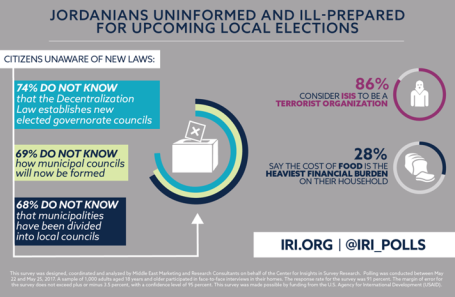 |
|
Source: The International Republican Institute. |
In order to comply with IMF-mandated macroeconomic reforms, the Jordanian government has indicated that it may increase personal income taxes in order to raise government revenue and ease the public debt burden. Some analysts are concerned that if such changes are insufficiently explained to the public, there could be a backlash against tax increases, especially amongst lower income groups who are dependent on the public services and subsidies that have been reduced to comply with IMF lending.29 According to polling by the International Republican Institute (IRI), "the under-performing economy is starting to have a greater impact on Jordanian citizens. Just 22 percent of Jordanians describe the economic situation as 'good' (20 percent) or 'very good' (2 percent), continuing a downward trend from a high of 49 percent (46 percent 'good,' 3 percent 'very good') in 2015."30
U.S. Foreign Assistance to Jordan
The United States has provided economic and military aid to Jordan since 1951 and 1957, respectively. Total bilateral U.S. aid (overseen by State and the Department of Defense) to Jordan through FY2016 amounted to approximately $19.2 billion. Jordan has received $909 million in additional military aid since FY2014, with more being channeled through the Defense Department's security assistance accounts.
New U.S.-Jordanian Agreement on Foreign Assistance
|
Figure 5. New U.S.-Jordanian MOU Amman, Jordan |
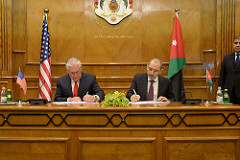 |
|
Source: U.S. State Department |
On February 14, 2018, U.S. Secretary of State Rex W. Tillerson and Jordanian Minister of Foreign Affairs Ayman Safadi signed a new Memorandum of Understanding (or MOU) on U.S. foreign assistance to Jordan. The MOU, the third such agreement between the United and Jordan, commits the United States to provide $1.275 billion per year in bilateral foreign assistance over a five-year period for a total of $6.375 billion (FY2018-FY2022). This latest MOU represents a 27% increase in the U.S. commitment to Jordan above the previous iteration and is the first five-year MOU with the kingdom. The previous two MOU agreements had been in effect for three years. According to the U.S. State Department, the United States is the single largest donor of assistance to Jordan, and the new MOU commits the United States to provide a minimum of $750 million of Economic Support Funds (ESF) and $350 million of Foreign Military Financing (FMF) to Jordan between FY2018 and FY2022.31 In line with the new MOU, for FY2019 President Trump is requesting $1.271 billion for Jordan, including $910.8 million in ESF, $350 million in FMF, and $3.8 million in International Military Education and Training (IMET).
Economic Assistance
The United States provides economic aid to Jordan both as a cash transfer and for USAID programs in Jordan. The Jordanian government uses cash transfers to service its foreign debt. Approximately 40% to 60% of Jordan's ESF allotment may go toward the cash transfer.32 USAID programs in Jordan focus on a variety of sectors including democracy assistance, water preservation, and education (particularly building and renovating public schools). In the democracy sector, U.S. assistance has supported capacity-building programs for the parliament's support offices, the Jordanian Judicial Council, the Judicial Institute, and the Ministry of Justice.
The International Republican Institute and the National Democratic Institute also have received U.S. grants to train, among other groups, some Jordanian political parties and members of parliament. In the water sector, the bulk of U.S. economic assistance is devoted to optimizing the management of scarce water resources, as Jordan is one of the most water-deprived countries in the world. USAID is currently subsidizing several waste treatment and water distribution projects in the Jordanian cities of Amman, Mafraq, Aqaba, and Irbid.
Humanitarian Assistance for Syrian Refugees in Jordan
The U.S. State Department estimates that, since large-scale U.S. aid to Syrian refugees began in FY2012, it has allocated more than $1.1 billion in humanitarian assistance from global accounts for programs in Jordan to meet the needs of Syrian refugees and, indirectly, to ease the burden on Jordan.33 U.S. aid supports refugees living in camps (~141,000) and those living in towns and cities (~500,000). According to the State Department, U.S. humanitarian assistance is provided both as cash assistance and through programs to meet basic needs, such as child health care, water, and sanitation.
The U.S. government provides cross-border humanitarian and stabilization assistance to Syrians via programs monitored and implemented through the Embassy Amman-based Southern Syria Assistance Platform. This includes humanitarian assistance to areas of southern and eastern Syria that are otherwise inaccessible, as well as congressionally-authorized stabilization and non-lethal assistance to opposition-held areas in southern Syria. According to USAID, U.S. humanitarian assistance funds are enabling UNICEF to provide health assistance for Syrian populations sheltering at the informal Rukban and Hadalat settlements along the Syria-Jordan border berm, including daily water trucking, the rehabilitation of a water borehole, and installation of a water treatment unit in Hadalat.34
Loan Guarantees
The Obama Administration provided three loan guarantees to Jordan, totaling $3.75 billion.35 These include the following:
- In September 2013, the United States announced that it was providing its first-ever loan guarantee to the Kingdom of Jordan. USAID notified Congress of its intent to obligate up to $120 million in FY2013 ESF-OCO to support a $1.25 billion, seven-year sovereign loan guarantee for Jordan.
- In February 2014, during a visit to the United States by King Abdullah II, the Obama Administration announced that it would offer Jordan an additional five-year, $1 billion loan guarantee. USAID notified Congress of its intent to obligate $72 million out of the $340 million of FY2014 ESF-OCO for Jordan to support the subsidy costs for the second loan guarantee.
- In June 2015, the Obama Administration provided its third loan guarantee to Jordan of $1.5 billion. USAID notified Congress of its intent to obligate $221 million in FY2015 ESF to support the subsidy costs of the third loan guarantee to Jordan.36
Military Assistance
Foreign Military Financing
U.S.-Jordanian military cooperation is a key component in bilateral relations. U.S. military assistance is primarily directed toward enabling the Jordanian military to procure and maintain conventional weapons systems.37 The United States and Jordan have jointly developed a five-year procurement plan for the Jordanian Armed Forces in order to prioritize Jordan's needs and procurement budget using congressionally-appropriated Foreign Military Financing (FMF). Proposed arms sales notified to Congress include 35 Meter Coastal Patrol Boats; M31 Unitary Guided Multiple Launch Rocket Systems (GMLRS) Rocket Pods; UH-60M VIP Blackhawk helicopter; and repair and return of F-16 engines.38 On February 18, 2016, President Obama signed the United States-Jordan Defense Cooperation Act of 2015 (P.L. 114-123), which authorizes expedited review and an increased value threshold for proposed arms sales to Jordan for a period of three years. In January 2018, the United States delivered two S-70 Blackhawk helicopters to Jordan, bringing their total Blackhawk fleet up to 28 aircraft.
|
Figure 6. Blackhawk Helicopters arriving in Jordan January 2018 |
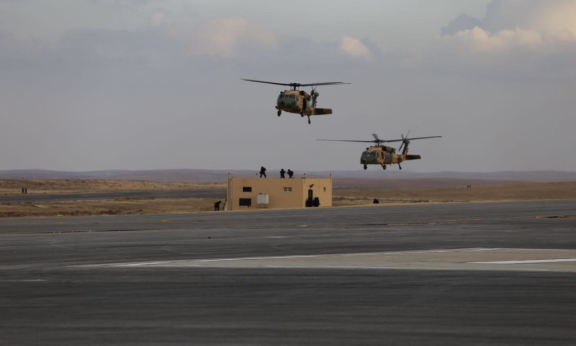 |
|
Source: U.S. Embassy in Jordan |
Excess Defense Articles
In 1996, the United States granted Jordan Major Non-NATO Ally (MNNA) status, a designation that, among other things, makes Jordan eligible to receive excess U.S. defense articles, training, and loans of equipment for cooperative research and development.39 In the last five years, Jordan has received excess U.S. defense articles, including two C-130 aircraft, HAWK MEI-23E missiles, and cargo trucks.
Defense Department Assistance
As a result of the Syrian civil war and Operation Inherent Resolve against IS, the United States has increased military aid to Jordan and channeled these increases through Defense Department-managed accounts. Although Jordan still receives the bulk of U.S. military aid from the FMF account, Congress has authorized defense appropriations to strengthen Jordan's border security. Congress has authorized Jordan to receive funding from various accounts such as: (1) Section 1206/10 U.S.C. 2282 Authority to Build Partner Capacity,40 (2) the Counterterrorism Partnerships Fund (CTPF),41 and (3) Department of Defense Operations & Maintenance Funds (O&M).42 Activities permitted under 10 U.S.C. 2282 have been incorporated into a new, broader global train and equip authority established by Section 1241(c) of the FY2017 NDAA: 10 U.S.C. 333.43 Military aid provided by these accounts is generally coordinated through a joint Defense Department (DOD)-State Department (DOS) review and approved by the Secretary of Defense, with the concurrence of the Secretary of State.
|
Account |
FY2014 |
FY2015 |
FY2016 |
FY2017 |
FY2018 est. |
FY2019 Request |
|
State Dept.—ESF (+OCO) |
700.000 |
615.000 |
812.350 |
832.350 |
TBD |
910.800 |
|
State Dept.—FMF (+OCO) |
300.000 |
385.000 |
450.000 |
470.000 |
TBD |
350.000 |
|
State Dept.—NADR |
6.700 |
7.200 |
8.850 |
13.600 |
TBD |
TBD |
|
IMET |
3.500 |
3.800 |
3.733 |
3.879 |
TBD |
3.800 |
|
DOD O&M (Coalition Support Funds) |
— |
75.000 |
117.000 |
— |
TBD |
TBD |
|
Counter-ISIS Train and Equip (CTEF) Border Security Reimbursement |
— |
— |
— |
75.000 |
TBD |
TBD |
|
DOD—1206/2282 (CTPF) |
— |
276.930 |
162.930 |
73.100 |
— |
— |
|
DOD—2282 |
— |
80.500 |
55.000 |
55.00 |
TBD |
TBD |
|
DOD-10 U.S.C. 333 |
— |
— |
— |
— |
19.43 |
— |
|
Total |
1,010.200 |
1,443.430 |
1,609.863 |
1,522.529 |
TBD |
1,264.600 |
Source: U.S. State and Defense Departments.
Recent Legislation
S. 1780, Department of State, Foreign Operations, and Related Programs Appropriations Act, 2018. Would provide $1.5 billion in total aid to Jordan, of which not less than $1.082 billion shall be in ESF, $400 million in FMF. The bill also directs that $745.1 million in ESF be set aside for cash transfer to the government of Jordan. The bill also would authorize ESF funds from the act and prior acts to support the costs of loan guarantees for Jordan. In report language accompanying the bill, appropriators direct the Secretary of State to "negotiate an MOU with Jordan in a timely manner, particularly as the current MOU expired in fiscal year 2017."
The National Defense Authorization Act for FY2018 (P.L. 115-91). The FY2018 NDAA authorizes $143 million in Air Force construction funds to expand the ramp space at Muwaffaq Salti Air Base in Azraq, Jordan.
H.R. 2646, United States-Jordan Defense Cooperation Extension Act. Would amend the United States-Jordan Defense Cooperation Act of 2015 to extend Jordan's inclusion among the countries eligible for certain streamlined defense sales until December 31, 2022. The bill also would authorize an enterprise fund to provide assistance to Jordan. It was passed in the House on February 5, 2018.
|
Account |
1946-2011 |
FY2012 |
FY2013 |
FY2014 |
FY2015 |
FY2016 |
1946-2016 |
|
FMF |
3,380.800 |
300.000 |
284.800 |
300.000 |
385.000 |
450.000 |
5,100.600 |
|
ESF |
6,043.800 |
485.500 |
542.900 |
329.600 |
594.700 |
812.350 |
8,808.850 |
|
INCLE |
3.800 |
1.200 |
— |
0.800 |
0.200 |
— |
6.000 |
|
NADR |
110.600 |
18.400 |
12.200 |
6.100 |
5.400 |
8.850 |
166.300 |
|
IMET |
70.700 |
3.700 |
3.600 |
3.600 |
3.800 |
3.733 |
89.400 |
|
MRA |
82.100 |
35.200 |
167.100 |
157.600 |
162.500 |
tbd |
604.500 |
|
Other |
2,963.500 |
330.100 |
199.400 |
345.700 |
365.400 |
322.930 |
4,527.030 |
|
Total |
12,655.300 |
1,174.100 |
1,210.000 |
1,143.400 |
1,517.000 |
1,597.863 |
19,297.663 |
Source: USAID Overseas Loans and Grants, July 1, 1945-September 30, 2015.
Notes: "Other" accounts include economic and military assistance programs administered by USAID, State, and other federal agencies which are funded at less than $2 million annually. It also includes larger, more recent funding through the International Disaster Assistance account (IDA), Millennium Challenge Account, and several defense department funding accounts. It also encapsulates much larger legacy programs (food aid), some of which have been phased out over time.